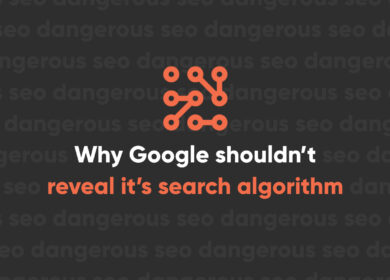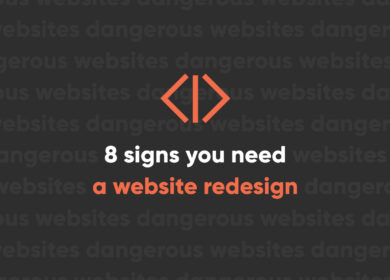
What to Look for in a Web Design Proposal

You’re pretty excited about the prospect of your company’s new website. Or at least you thought you were, until a handful of web designers responded to your website RFP with what amounts to over 100 pages of proposals. Now you have to sort through all these pages and choose the best designer for the job. It seems impossible to pick. Maybe you should just throw them all down the stairs and go with the one that lands at the bottom first.
Given that your new website is going to dictate the future success of your company, you probably don’t want to leave it to chance. But what in the world are you looking for (other than a price that fits within your budget)? Here are 10 things to help you find the best proposal in the bunch.
A Professional Document
The good web design companies will respond to your RFP with a well-thought-out document that fully details your needs, the scope of the project, their capabilities, the cost, and much more. Anyone who doesn’t give you a detailed document should be ruled out immediately. You definitely don’t want to work with someone who doesn’t clearly define the purpose and scope of the project. If they get back to you with a simple email that says, “We’ll do it for $5,000,” then you should immediately rule them out. The good proposals will be long. We’re talking 20+ pages in many cases. While the length of the proposal shouldn’t be the deciding factor, anything that feels half-assed or unprofessional should give you a good idea of what the final results of the website will be. The bottom line: the proposal document should make it clear that they took your RFP seriously and they really want to design your new website.
Client Background
You know who you are, so you don’t need to spend hours reading about yourself. But a web design proposal that outlines your background should tell you something very important: they were listening to you. They know who you are and what you need. Ideally, this will include a brief company intro, the current state of the website, and your target audiences. The client background should be one of the first sections of the proposal, and it should be detailed and accurate.
Project Details
You know what you want your new website to do. Does your web design company? The proposal should outline your desired state, your design and development guidelines, and your website objectives. This should all sound familiar. It’s everything you told the company you wanted during the due diligence. But this is more than an exercise in listening. It’s an exercise in web design competency. After reading this section, you’ll know they know exactly what you want the new website to accomplish.
Project Scope
The project scope should build from the project details. The details section is an overview of what the website needs to do. The scope explains specifically what they will do to make this happen. It should include the number of templates they will design, the different types of layouts, the integrations, the functionality, and everything else that will be included in the project. This section defines everything they are going to do, so make sure you understand it thoroughly. If you sign the proposal and something wasn’t in this section, you’re going to pay extra for it. Look for a clearly defined project scope that indicates what’s included and what’s not included.
Recommended CMS
You may have a set content management system (CMS) in mind heading into the project. Or maybe you are open to suggestions. Either way, the proposal should make a clear recommendation regarding the best CMS for your project. In most cases, you want an open source CMS rather than a proprietary one. If the proposal recommends a proprietary CMS, it should clearly explain why their CMS is better than the proven systems that are trusted by millions of successful companies. Make sure you understand the features and benefits of the CMS the proposal suggests.
Company Background
You already know about the web design company a little bit from your research and the initial due diligence before the proposal. The proposal should be more about you than them, but it still has to include specific details about the company’s background and capabilities. A big bonus if it shows you specific people who will be overseeing your project. After reading the company background in the context of the proposal, you should feel confident that they are the right size and fit for your new website.
Methodology
You want to know they are capable. You also need to know how they work. The proposal should outline their strategy and their approach to design and development. It should show the process and how they track the project. Will you be constantly emailing documents back and forth, or do they use a tool like Basecamp to make project management easy and convenient for everyone? Their methodology should make you confident that they know what they are doing and that they can handle your project without making it too stressful on you. A big bonus if they highlight their skills in UI/UX.
Terms & Conditions
This isn’t a section of boring legalese. This is a section that clearly identifies the payment terms, the guarantees, and the ownership of the project. You need to know when and how you are supposed to pay. You need to know any extra charges you may incur. You need to know what they are going to do if something is broken. Most importantly, you need to know who owns the website when it launches. If the terms & conditions section doesn’t include “the site will be copyright and property of [your name] once fully paid,” then you do not want to sign the proposal.
Examples of Relevant Work
Obviously you can see what they’ve done from their online portfolio, but the proposal should clearly show examples of similar work that demonstrates the company’s competency for your specific project. If you want an ecommerce site and they only send you B2B lead generation examples, then they aren’t the right company. Look for a proposal that contains 3-5 past projects that are relevant to your project.
Detailed Quote
The final page of the proposal should be what you were looking for all along (but resist the temptation to go to this page first). This is the quote. This is where the web design company tells you how much this project is going to cost. It should contain an itemized list of the one-time project costs. You want to see exactly how much they are charging for content writing, project management, design, development, testing, training, etc. Don’t trust a proposal that lumps everything together under one sum. It also should include any monthly or ongoing costs, such as hosting, marketing, etc. There should be no surprises after the quote. This is what you are going to pay. Period.
Making the Decision
Believe it or not, the price is not the single most important part of the proposal. The rest of the proposal should justify the price. By the time you get to that quote page, you should want to hire them no matter what it’s going to cost. If the proposal doesn’t do that, then the price doesn’t really matter.

Nate Tower
Nate Tower is the President of Perrill and has over 12 years of marketing and sales experience. During his career in digital marketing, Nate has demonstrated exceptional skills in strategic planning, creative ideation and execution. Nate's academic background includes a B.A. with a double major in English Language and Literature, Secondary Education, and a minor in Creative Writing from Washington University. He further expanded his expertise by completing the MBA Essentials program at Carlson Executive Education, University of Minnesota.
Nate holds multiple certifications from HubSpot and Google including Sales Hub Enterprise Implementation, Google Analytics for Power Users and Google Analytics 4. His unique blend of creative and analytical skills positions him as a leader in both the marketing and creative worlds. This, coupled with his passion for learning and educating, lends him the ability to make the complex accessible and the perplexing clear.



